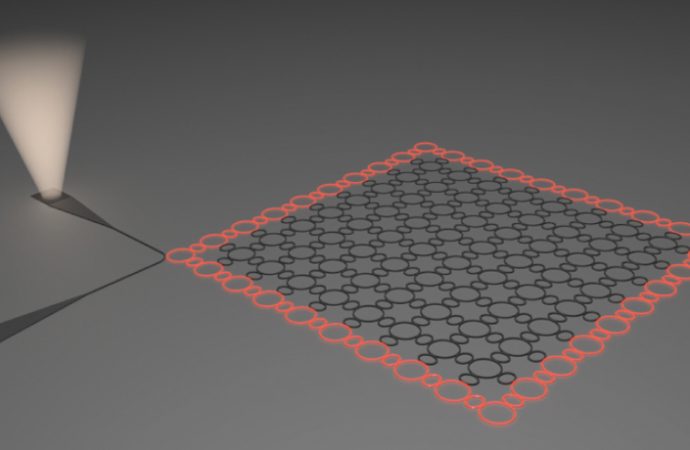A design based on exotic materials lets scientists better control the flow of light particles
A new type of laser is modeled after an exotic class of materials called topological insulators. And it’s proving more reliable and energy-efficient than its conventional counterparts, paving the way for possible use in quantum communication and next-generation electronics.
The device, described online February 1 in Science, is composed of a grid of semiconductor rings that convert energy into particles of light. The device then channels these photons in a single direction around the grid to until they are emitted as a beam.
The design borrows from the concept behind topological insulators — a kind of material that blocks electric current through its interior but let electrons surf along its surface (SN: 5/22/10, p. 22). Scientists have engineered devices that similarly steer sound waves along their edges, but researchers debated whether that same kind of control could be exerted over the light particles generated inside lasers (SN: 5/2/15, p. 9). This new laser design settles the debate.
Measuring up
The new topological insulator laser is more efficient than its conventional counterpart — that is, the intensity of the laser beam is stronger for how much power it consumes.

To turn on the laser, the researchers feed light or electrical energy into the grid’s outer rings, which convert that energy into the laser’s light. The rings are linked together by racetrack-shaped loops precisely positioned to steer those light particles along a one-way path. While only the outer rings transmit the laser light, the whole grid of rings is needed to help guide the photons, says Boubacar Kante, an electrical and computer engineer at the University of California, San Diego, who wasn’t involved in the work.
Ferrying light along the grid’s outer edge in a single direction makes the laser more immune to manufacturing errors or malfunctions that can cripple other lasers, says study coauthor Mordechai Segev, a scientist at the Israel Institute of Technology in Haifa. If photons encounter a defect, like a missing ring, they can’t bounce back or scatter, which would waste energy. Instead, the photons are forced to go around the rough patch and continue on.
These reliable lasers could be used for sending information in a quantum network, says Li Ge, a physicist at the City University of New York not involved in the work (SN: 10/15/16, p. 13). And physicist Alexander Khanikaev, also at the City University of New York, suggests the new lasers might also be used to build better optical circuits. These circuits, which transmit information via light rather than electricity, could help make faster, more efficient electronics.
Source: Science News

































Leave a Comment
You must be logged in to post a comment.